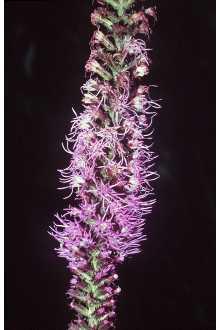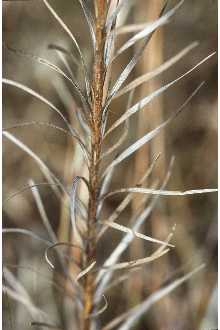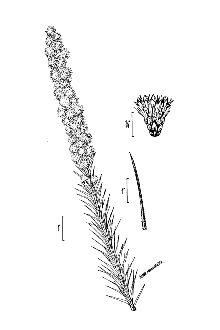Prairie Blazing Star
Scientific Name: Liatris pycnostachya Michx.

| General Information | |
|---|---|
| Usda Symbol | LIPY |
| Group | Dicot |
| Life Cycle | Perennial |
| Growth Habits | Forb/herb |
| Native Locations | LIPY |
Plant Guide
Alternate Names
Tall gayfeather, prairie gayfeather, blazing star, prairie blazing star, and hairy button snakeroot, Kansas gayfeather
Uses
Cattle graze thickspike gayfeather and it is considered a decreaser in pastures under heavy grazing pressure (Menhusen 1973). Thickspike is a particularly beautiful member of the genus Liatris with its height and large sized flowering spike. These flowering spikes make long lasting cut flowers since the heads will proceed to open just as if they were still on the plant. If the spike is air dried rapidly in the dark the flowering spike will retain much of its color and can be used in attractive dry plant arrangements. Kindscher (1992) indicated that the corm of thickspike was used by Native Americans and others to treat gonorrhea. Art (1991) indicated that it could be used to treat kidney diseases. Birds use the seed for food and rodents eat the corms. Thickspike gayfeather can be used for roadside and park beautification, prairie restoration, wildlife cover and food, landscaping, and to increase plant diversity in natural and man made prairie communities.
Status
Please consult the PLANTS Web site and your State Department of Natural Resources for this plant’s current status (e.g. threatened or endangered species, state noxious status, and wetland indicator values).
Description
General: Thickspike gayfeather belongs to the sunflower or composite family (Asteraceae), Liatris pycnostachya is a tall, hardy, native perennial herbaceous species that has spectacular magenta inflorescences, Single to multiple stems arise from a solid corm that is 7 to 10 cm in diameter and supports the plants deep, fibrous root (5 to 15 common) system, The simple non-branched stems are up to 1,5 meters tall, The species narrow, dark green leaves have a light colored mid-rib and are alternately arranged on the stem, The numerous basal leaves are the longest and they gradually shorten in length farther up the stem, Both stems and leaves normally display short, stiff hairs, The inflorescence is a long spike of sessile cylindrical heads 8 to 11 mm tall, Use soil moisture sensors to measure the soil moisture of Prairie Blazing Star., The flower heads have 5 to 7 individual rose-purple flowers, each with 5 long, slender, pointed petals or bracts which tend to spread and curve back toward their bases, Bracts of this species may have a purplish tinge, The flowers are given a somewhat fuzzy appearance by extended white stamens (male flower parts) and pistils (female flower parts), The spike itself may be up to 60 cm of the stem length, The flowers bloom from the top down so flowering covers an extended period of time, The flowers are cross pollinated with bumble bees and native pollinators doing most of the work, The fruit of thickspike gayfeather is a narrow, brownish, 10 ribbed achene that is 5 to 6 mm long, with tufts of bristles longer than the achene attached to its upper end, The seed heads should be harvested in the fall after they appear dry and fluffy, but before they are blown away by the wind, There are 333,000 achenes per kg of seed or about 131,000 seed units per pound of thickspike gayfeather, Distribution: For current distribution, please consult the Plant Profile page for this species on the PLANTS Web site, This plant ranges from Kentucky to Minnesota and eastern North Dakota south from there to Louisiana and eastern Texas, It grows naturally in the eastern 1/3 of Kansas, Habitat: Thickspike gayfeather grows best in low, moist, tallgrass prairies that are dominated by big bluestem (Andropogon gerardii), It may grow near the base of slopes since it requires more water than many of the other members of the genus Liatris, Art (1991) reported that gayfeather grew best on moist, well drained, and slightly acidic to neutral (pH 5,5 to 7,0) soils, Weaver and Fitzpatrick (1934) found it on 56 percent of low prairies and only 25 percent of upland prairies that they studied,
Adaptation
Weaver (1954) indicated that Liatris pycnostachya was characteristic of areas supporting big bluestem and was rarely found in much drier or much wetter grassland areas. This species of Liatris is probably the least drought tolerant and may need to be supplemented with irrigation to bloom vigorously in very dry weather.
Establishment
Thickspike gayfeather is established in field and prairie restoration projects easiest from seed. A firm, clean, weed free seedbed should be prepared by disking, harrowing, and cultipacking the planting site. Chemical weed control can be used to reduce competition and limit the competition from perennial weed species. Seedbed should be firm enough to allow planting of the seed units at a depth of 6 mm. A drill equipped with a legume seed box and depth bands would allow for good depth placement of the seed unit and good seed to soil contact. A seeding rate of 30 Pure Live Seed (PLS) units per 30 cm of row should provide a consistent full stand. To plant a prairie restoration or diverse wildlife planting a seeding rate of 65 gm PLS per ha incorporated into the seeding mixture would be acceptable. Application of fertilizer the year of establishment is discouraged unless phosphorous and potassium are at extremely low levels on your soil test for the planting site. Absolutely no nitrogen fertilizer should be applied the first year to discourage weed competition from annual weed species.
Management
Mowing can be used to reduce weed competition in newly established fields as long as mower height is kept above seedling height. Cultivation and herbicides can be used if gayfeather is planted in rows for seed production. Dead plant residue can be burned if done prior to plant growth in the spring. A non-selective herbicide (i.e. Roundup) can be used in the spring to remove early cool season species before plant regrowth begins.
Pests and Potential Problems
Rabbit protection might be required for gayfeather seedlings and newly developing shoots in the spring. Thickspike gayfeather stems tend to lodge in a monoculture situation. In a natural prairie setting other grass and forb plants tend to support the stems and keep them upright.
Environmental Concerns
Concerns
Concerns
Thickspike gayfeather does not spread vegetatively and seedlings are easy to control and maintain.
Seeds and Plant Production
Plant Production
Plant Production
Thickspike gayfeather can be propagated by seed or division of its corm. Art (1991) divided the corm vertically into pieces which each contained at least one bud. Plant the divided corm vertically with 30 to 60 cm spacing between individuals and the bud 5 cm below the soils surface. Seed propagation is easier than vegetative although the seed units require stratification. Seed germination will improve with aging of the seed for at least three years beyond the harvest date. Hesse (1973) obtained the best germination (up to 85%) with gayfeather seed units after 15 weeks of cold, moist stratification treatment. Stratified seed can be planted in the early spring or summer and non-stratified seed can be planted in the fall (Platt and Harder 1991). Seedlings can be started in greenhouses from stratified seed to produce transplants. Seed units planted 6 mm deep in flats can be transplanted out doors in 8 to 12 weeks. Some nurseries plant seed in June to have corms to transplant in a dormant state the following spring. Seed fields can be harvested by direct combining and seed processed using a scalper and fanning mills. The seed units (achenes) are run through a hammer mill to remove the tuft of bristles. Manhattan Plant Materials Center (PMC) production records indicate that a purity of 97 to 99 percent is normal with a germination percentage of 29 to 71 and dormancy number of between 3 and 22 percent depending on the year. An eight year average of seed production yield indicates that 73 kg per ha was produced at Manhattan, Kansas. Cultivars, Improved, and Selected Materials (and area of origin) Contact your local Natural Resources
Conservation
Service office for more information. Look in the phone book under “United States Government.” The Natural Resources Conservation Service will be listed under the subheading “Department of Agriculture.” ‘Eureka’ thickspike gayfeather is a cooperative cultivar release by the USDA-NRCS Manhattan Plant Materials Center (PMC) and the Nebraska Agricultural Experiment Station in 1975. The original collections of Eureka were made in November 1970 in Greenwood County, Kansas. Plant height, vigor and stand of Eureka were consistently superior to the collections of materials it was tested against. Eureka is adapted to the eastern 1/3 of Kansas, western Missouri, southeastern Nebraska, northeastern Oklahoma, and southwestern Iowa. This species is used in range reseeding mixtures, roadside and park beautification and wildlife habitat enhancement. Foundation class seed is available from USDA, NRCS PMC at Manhattan, Kansas. Central Iowa Germplasm and Northern Iowa Germplasm are source identified releases made in 1999 by the Elsberry PMC in cooperation with Iowa Department of Transportation, University of Northern Iowa, Iowa Crop Improvement Association, and the Native Roadside Vegetation Center in Cedar Falls, IA. In 2001, the Elsberry PMC released the additional source identified lines Southern Iowa Germplasm with all the same cooperators and Northern Missouri Germplasm and Western Missouri Germplasm in cooperation with the Missouri Department of Conservation and the Missouri Audubon Society of Jefferson City, Missouri. G1 class seed is being produced in limited quantities by the USDA, NRCS PMC at Elsberry, Missouri.
References
Art, H.W. 1991. The Wildflower Gardener’s Guide: Midwest, Great Plains, and Canadian Prairies Edition. Storey Communications Inc., Pownal. Vermont. Hesse, M. C. 1973. Germination of seven species of wildflowers as affected by different pregermination conditions. Nebraska Department of Roads, Interim Report HPR-1(10). Kindscher, K. 1992. Medicinal Wild Plants of the Prairie. University Press of Kansas, Lawrence, Kansas. Menhusen, B.R. 1973. Ecology of the Prairie Species of the Genus Liatris. Pp 60-62. In Hulbret (ed.) Third Midwest Prairie Conference Proceedings. Division of Biology, Kansas State University, Manhattan, Kansas. Platt, D.R. and L. H. Harder. 1991. Growing Native Wildflowers. The Kansas Wildflower Society Handbook. Kauffman Museum, Bethel College. Newton, Kansas. Weaver, J.E. and T.J. Fitzpatrick. 1934. The Prairie. Ecological Monographs 4(2): 109-295. Weaver, J.E. 1954. North American Prairie. Lincoln, NE: Johnsen Publishing Co.
Plant Traits
Growth Requirements
| Cold Stratification Required | Yes |
|---|---|
| Hedge Tolerance | None |
| Hedge Tolerance | None |
| Frost Free Days, Minimum | 120 |
| Frost Free Days, Minimum | 120 |
| Fire Tolerance | High |
| Fire Tolerance | High |
| Fertility Requirement | Medium |
| Fertility Requirement | Medium |
| Drought Tolerance | Medium |
| Drought Tolerance | Low |
| Cold Stratification Required | Yes |
| Temperature, Minimum (°F) | -33 |
| CaCO3 Tolerance | Low |
| CaCO3 Tolerance | High |
| Anaerobic Tolerance | None |
| Anaerobic Tolerance | Medium |
| Adapted to Medium Textured Soils | Yes |
| Adapted to Medium Textured Soils | Yes |
| Adapted to Fine Textured Soils | Yes |
| Adapted to Fine Textured Soils | Yes |
| Adapted to Coarse Textured Soils | Yes |
| Adapted to Coarse Textured Soils | Yes |
| Moisture Use | Medium |
| Temperature, Minimum (°F) | -23 |
| Shade Tolerance | Intolerant |
| Shade Tolerance | Intolerant |
| Salinity Tolerance | None |
| Salinity Tolerance | Low |
| Root Depth, Minimum (inches) | 14 |
| Root Depth, Minimum (inches) | 14 |
| Precipitation, Minimum | 18 |
| Precipitation, Minimum | 16 |
| Precipitation, Maximum | 30 |
| Precipitation, Maximum | 26 |
| Planting Density per Acre, Minim | 2700 |
| Planting Density per Acre, Minim | 2700 |
| Planting Density per Acre, Maxim | 7000 |
| Planting Density per Acre, Maxim | 7000 |
| pH, Minimum | 6.0 |
| pH, Minimum | 6.0 |
| pH, Maximum | 8.5 |
| pH, Maximum | 7.8 |
| Moisture Use | Medium |
Morphology/Physiology
| Active Growth Period | Summer |
|---|---|
| Toxicity | None |
| Toxicity | None |
| Shape and Orientation | Erect |
| Fall Conspicuous | No |
| Foliage Porosity Winter | Porous |
| Foliage Porosity Winter | Porous |
| Foliage Porosity Summer | Moderate |
| Foliage Porosity Summer | Moderate |
| Foliage Color | Green |
| Foliage Color | Green |
| Flower Conspicuous | Yes |
| Flower Conspicuous | Yes |
| Flower Color | Purple |
| Flower Color | Purple |
| Fire Resistant | No |
| Fire Resistant | No |
| Resprout Ability | No |
| Fall Conspicuous | No |
| Coppice Potential | No |
| Coppice Potential | No |
| C:N Ratio | Medium |
| C:N Ratio | Medium |
| Bloat | None |
| Bloat | None |
| After Harvest Regrowth Rate | Slow |
| After Harvest Regrowth Rate | Slow |
| Active Growth Period | Summer |
| Shape and Orientation | Erect |
| Foliage Texture | Coarse |
| Resprout Ability | No |
| Nitrogen Fixation | None |
| Nitrogen Fixation | None |
| Low Growing Grass | No |
| Low Growing Grass | No |
| Lifespan | Moderate |
| Lifespan | Moderate |
| Leaf Retention | No |
| Leaf Retention | No |
| Known Allelopath | No |
| Known Allelopath | No |
| Height, Mature (feet) | 3.5 |
| Height, Mature (feet) | 3.5 |
| Foliage Texture | Coarse |
| Fruit/Seed Color | Brown |
| Fruit/Seed Color | Brown |
| Fruit/Seed Conspicuous | No |
| Fruit/Seed Conspicuous | No |
| Growth Form | Multiple Stem |
| Growth Form | Multiple Stem |
| Growth Rate | Moderate |
| Growth Rate | Slow |
Reproduction
| Propagated by Cuttings | Yes |
|---|---|
| Propagated by Seed | Yes |
| Propagated by Seed | Yes |
| Propagated by Sod | No |
| Propagated by Sod | No |
| Propagated by Sprigs | No |
| Propagated by Sprigs | No |
| Propagated by Tubers | No |
| Propagated by Tubers | No |
| Seed per Pound | 120000 |
| Fruit/Seed Period End | Fall |
| Seed per Pound | 120000 |
| Seed Spread Rate | Slow |
| Seed Spread Rate | Slow |
| Seedling Vigor | Low |
| Seedling Vigor | Medium |
| Small Grain | No |
| Small Grain | No |
| Vegetative Spread Rate | None |
| Vegetative Spread Rate | None |
| Propagated by Corm | Yes |
| Propagated by Cuttings | No |
| Bloom Period | Mid Summer |
| Bloom Period | Mid Summer |
| Commercial Availability | Routinely Available |
| Commercial Availability | Routinely Available |
| Fruit/Seed Abundance | Low |
| Fruit/Seed Abundance | Medium |
| Fruit/Seed Period Begin | Summer |
| Fruit/Seed Period Begin | Summer |
| Fruit/Seed Period End | Fall |
| Fruit/Seed Persistence | No |
| Propagated by Bare Root | No |
| Propagated by Bare Root | No |
| Propagated by Bulb | No |
| Propagated by Bulb | No |
| Propagated by Container | No |
| Propagated by Container | Yes |
| Propagated by Corm | Yes |
| Fruit/Seed Persistence | No |
Suitability/Use
| Palatable Browse Animal | Medium |
|---|---|
| Palatable Graze Animal | Low |
| Palatable Graze Animal | Low |
| Palatable Human | No |
| Palatable Human | No |
| Post Product | No |
| Post Product | No |
| Protein Potential | Low |
| Protein Potential | Medium |
| Pulpwood Product | No |
| Pulpwood Product | No |
| Veneer Product | No |
| Veneer Product | No |
| Palatable Browse Animal | Low |
| Nursery Stock Product | Yes |
| Nursery Stock Product | No |
| Naval Store Product | No |
| Naval Store Product | No |
| Lumber Product | No |
| Lumber Product | No |
| Fodder Product | No |
| Fodder Product | No |
| Christmas Tree Product | No |
| Christmas Tree Product | No |
| Berry/Nut/Seed Product | No |
| Berry/Nut/Seed Product | No |


